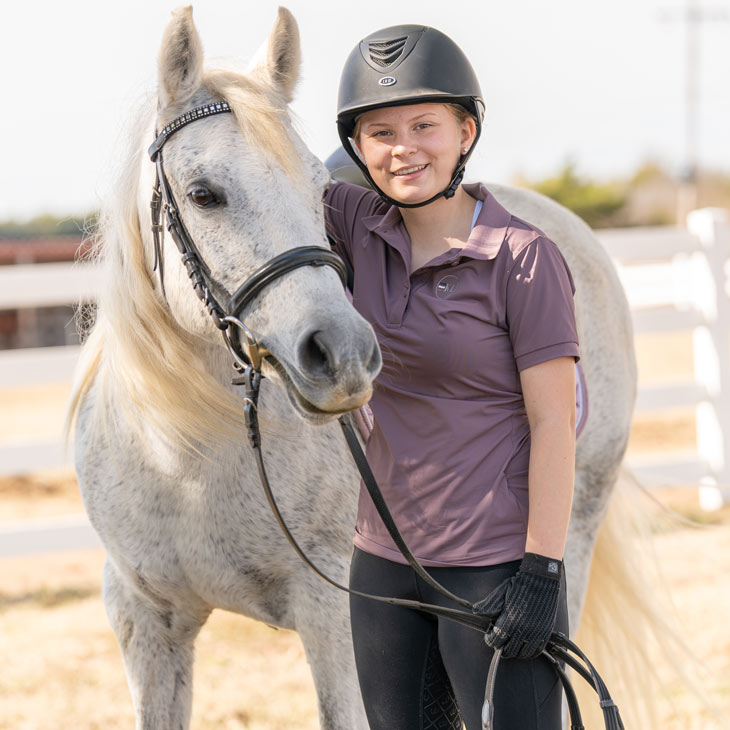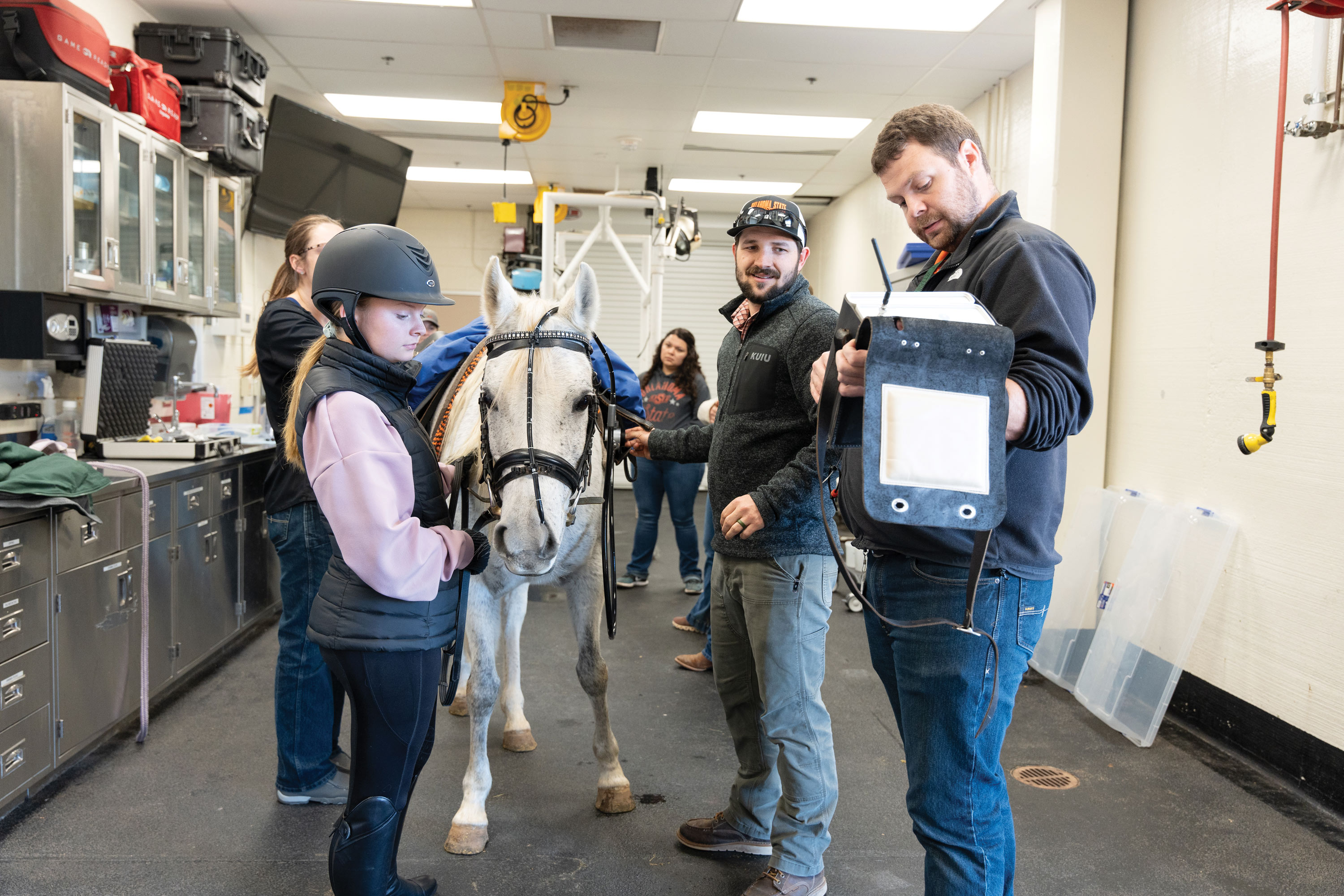
Overcoming Obstacles: OSU veterinarians alleviate mare's breathing issue, earn client's appreciation
Friday, January 19, 2024
Media Contact: Taylor Bacon | Public Relations and Marketing Coordinator | 405-744-6728 | taylor.bacon@okstate.edu
It can be a frightening experience for any owner when their animal is showing signs something may be wrong, especially when it is having trouble breathing.
Sarah Dorman and her daughter, Anna, brought April, an 11-yearold Arabian mare, to the Oklahoma State University Veterinary Medical Teaching Hospital because she was coughing and flaring her nostrils during exercise. While allergy issues were not uncommon for April, her symptoms appeared more severe this time.
Previously, the Dormans had a successful procedure at the OSU VMTH, so when April started experiencing symptoms, they had no doubts where they wanted her to go.

“OSU is one of the best places for equine care,” she said.
Dr. Dan Burba, professor of equine surgery and sports medicine, immediately got to work to determine what was wrong with April.
“The first step was resting upper respiratory endoscopy, which is performed to view the upper respiratory tract of a horse that has clinical signs such as breathing issues during exercise,” Burba said. “Dynamic endoscopy was performed to determine if the abnormality found on resting endoscopy was the cause of April’s breathing abnormal during exercise.”
During an endoscopy, a camera at the end of a flexible tube is inserted into the nose to view the back of the throat.
“This allows us to view the anatomy and function of the respiratory tract,” said Dr. Mike Schoonover, professor of equine surgery and sports medicine as well as large animal section chief. “In a normal horse, the epiglottis is positioned on top of the soft palate to allow normal breathing.”
Burba said April’s throat was scoped at rest and during exercise. This revealed the epiglottis, the triangular flap that closes the windpipe during swallowing, was trapped under the back part of her soft palate, otherwise known as a dorsally displaced soft palate.
While there are many different procedures designed to treat DDSP in horses, not all of them are effective in every situation, Schoonover said. Because April’s DDSP was consistently present and accompanied by ulceration and inflammation, the team recommended a staphylectomy. A staphylectomy is a surgical procedure to remove a small part of the soft palate.
While the Dormans said they were a bit apprehensive about April undergoing surgery, they knew she was in good hands with the OSU veterinarians.
Not only does OSU have equine surgeons who are well-equipped to handle complex issues, but they are also training the next generation of equine surgeons alongside them.
“We trimmed approximately five millimeters of soft palate from the back edge. No sutures were placed in the soft palate incision. The inner layer of the airway incision was sutured, and the remaining surgical incision was left to heal by second intention.”
Surgical residents Dr. David Wallace and Dr. Nick Lani were integral in performing the resting endoscopy and instrumenting April for the dynamic endoscopy, Schoonover said. Wallace then performed the surgical procedure with Schoonover’s direct supervision and guidance.
During the surgery, a skin incision was made under April’s throat that entered the airway just in front of her windpipe. The back edge of the soft palate was pulled into view using surgical forceps.
“We trimmed approximately five millimeters of soft palate from the back edge,” Schoonover said. “No sutures were placed in the soft palate incision. The inner layer of the airway incision was sutured, and the remaining surgical incision was left to heal by second
intention.”
The teaching component OSU provides to its patients is another aspect the Dormans appreciate about coming to the VMTH.
“Being in a teaching environment, they are willing to teach us as well,” Sarah said.
The veterinarians on April’s case involved Anna by explaining what they saw with the scope and the process of what the surgery would entail.
For Wallace and Lani, they gained valuable specialty training in the diagnosis, treatment and post-operative care of DDSP. Fourth-year veterinary students were also exposed to many elements of the case including history taking, patient examination, diagnostic imaging, diagnosis, treatment and preand post-operative care.
Much of April’s recovery was done at home, so Anna was able to watch April’s surgical wound heal as she tended to the cleaning and monitoring of the surgical area — a great learning experience for Anna.
When April was brought back in for her re-check endoscopy, her epiglottis was in its normal position resting above the back edge of the soft palate. Upon evaluation of her surgical wound, they found it was healing very well.
April is currently at home and back to her normal self. While Anna continues to monitor her, she is eager to show her this spring and start competing at high-level events.
The Dormans said they are grateful to all the hospital staff, from the front desk to the technicians and veterinarians.
“Thank you for being patient with us and taking such good care of her,” Anna said.
Sarah said she and Anna felt informed and cared about the entire way. As a mother, she is grateful to the hospital faculty and staff for helping her daughter and April get back to doing what they love.
Photos By: Taylor Bacon and Kinsey Reed
Story By: Taylor Bacon | Vet Cetera Magazine
